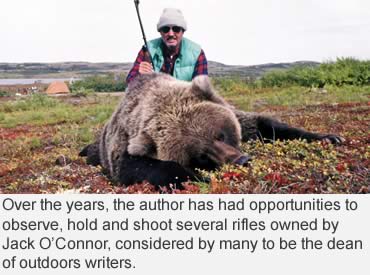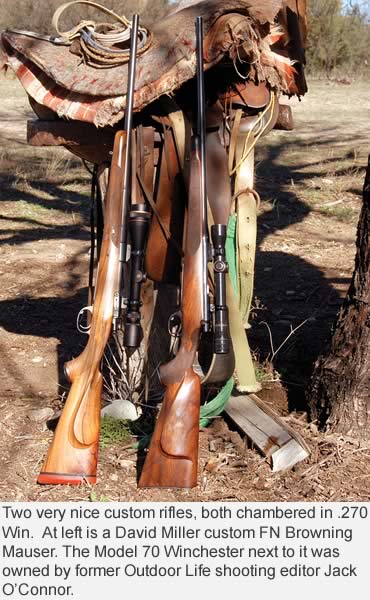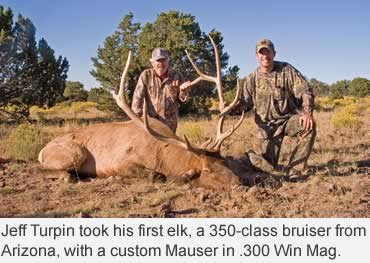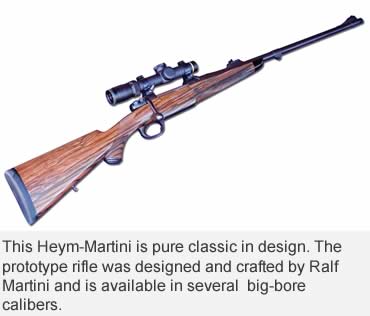Jack O’Connor’s favorite Model 70s are great examples of timeless elegance in rifle design.
Photo: Two of the author’s custom rifles based on Model 70 actions. The top rifle wears a stock of New Zealand walnut. The bottom rifle is in Circassian walnut.
It makes little difference whether comparing boats, cars, watches or firearms. Classic styling generally wins out over more contemporary designs.
There have been many efforts made to modernize 21st century rifle designs, but few, have succeeded.
The firearms turned out by the Germans in the late 19th and early 20th centuries were models of classic form and function. One need look no further that the great Mauser Werke in Oberndorf to prove this fact. Herr Mauser developed THE bolt action that has stood the test of time: the Model 98. A quick look at the Mauser sporting rifles produced in Oberndorf at the time reveals nothing but pure classic simplicity in both design and function.
 Fast forward to the 21st century and have a look at Teutonic firearms design. Peter Paul Mauser has surely turned over in his grave numerous times the past few years. The first notable departure from classic firearms design came out of Mauser’s factory and carried the Mauser name. If the Model 66 Mauser didn’t wake old Paul up, nothing will.
Fast forward to the 21st century and have a look at Teutonic firearms design. Peter Paul Mauser has surely turned over in his grave numerous times the past few years. The first notable departure from classic firearms design came out of Mauser’s factory and carried the Mauser name. If the Model 66 Mauser didn’t wake old Paul up, nothing will.
There is no question that the Mauser Model 66 was a revolutionary design. It was noted for several innovative design features, including a shorter overall length. It also included easily changed barrels in different calibers. It worked, and it worked very well. However, it was about as streamlined and sleek as a Toyota Scion and ugly with a capital U. I doubt that a dozen were sold in the entire U.S.
Don’t use this. Something happened to the German molecular makeup starting around the end of WWII. It seems to me an engineering gene replaced the classic styling gene, resulting in excellent function, but with no form whatsoever.
 A quick look at a Model 66 on a dark night would give a professional hangman nightmares. When it comes to attractive rifles, nothing much originating from middle-Europe since then has changed the trend. Some are as bad aesthetically as the Model 66 Mauser, and one or two are perhaps even worse.
A quick look at a Model 66 on a dark night would give a professional hangman nightmares. When it comes to attractive rifles, nothing much originating from middle-Europe since then has changed the trend. Some are as bad aesthetically as the Model 66 Mauser, and one or two are perhaps even worse.
It seems engineering is now valued above all else. Whether speaking of cars, rifles, or, washing machines for that matter, the Germans have developed functional marvels, each of which contains twice as many parts as would ordinarily be necessary.
The Italians have taken over the top row of the double shotgun in recent years. The Brits won’t agree with that assessment, but I believe it to be true. Italian doubles are svelte, lightweight, and in general, a delight to shoot and hunt with. London still rules the double rifle market, but the Italians are in their knickers when it comes to double shotguns, at least in my opinion.
 If that is true, and I believe it is, how does one explain the semiauto guns coming out of that country these days, and with great fanfare to boot. I don’t doubt that these machines are functional marvels. I’m willing to concede that they’ll shoot forever without a malfunction, but classic beauties they are not.
If that is true, and I believe it is, how does one explain the semiauto guns coming out of that country these days, and with great fanfare to boot. I don’t doubt that these machines are functional marvels. I’m willing to concede that they’ll shoot forever without a malfunction, but classic beauties they are not.
Over the past few years, I’ve had the opportunity to observe, shoot and handle several rifles that belonged to Jack O’Connor. I have photographed some of them as well. While working on a story on pre-64 Model 70s as fodder for building fine custom rifles, I dug out a few photos of Jack’s second favorite rifle of all time. I say second favorite, but for a few years it was his absolute favorite. His admiration for it was the reason for the existence of the rifle that later supplanted it and became his pet.
To clarify, in 1953 O’Connor bought a standard Winchester Model 70 factory rifle chambered for — give you three guesses — the .270 Winchester. He delivered it to Al Biesen with instructions to spiff it up for him.
Biesen slicked up the action, turned the standard factory barrel to a featherweight contour and shortened it to 22 inches, made a few modifications here and there, and stocked it in French walnut. O’Connor was enamored with the resulting rifle. In fact, he adored it.
He used it on several hunts, including a trip to Africa with Elgin Gates on trips to Iran and India and to take a wonderful Dall ram in the Yukon. Between these adventures, O’Connor took a couple of fine elk with it. He was so pleased with the rifle that he feared shooting out the barrel.
 Six years later, in 1959, he purchased a second Model 70 in .270 Winchester, this time a factory Featherweight model. He turned his new acquisition over to Biesen with instructions to basically duplicate the first rifle. His intent was to make the new rifle a backup to the original, using it for ordinary shooting while reserving the first for special applications. He even named them his Number 1 and Number 2 rifles.
Six years later, in 1959, he purchased a second Model 70 in .270 Winchester, this time a factory Featherweight model. He turned his new acquisition over to Biesen with instructions to basically duplicate the first rifle. His intent was to make the new rifle a backup to the original, using it for ordinary shooting while reserving the first for special applications. He even named them his Number 1 and Number 2 rifles.
As it turned out, the Number 2 rifle eventually became his all-time favorite rifle, and the Number 1 rifle became the backup — just the reverse of his original plan.
As O’Connor grew older and realized his hunting days were numbered, he sold many of his prized rifles. The Model 70 Number 1 went to his close friend Henry “Hank” Kaufman in Lewiston, Idaho.
A couple of years ago, I had the opportunity to accompany Hank and mutual friend Eldon “Buck” Buckner on a Coues deer hunt in Mexico. Kaufman brought along the Number 1 .270 to use on the hunt, providing me with the opportunity to handle and photograph the rifle.
The rifle was crafted more than 58 years ago. Its design and execution is a wonderful example of pure classic, timeless elegance. If I set out to build a fine custom .270 today, there are precious few changes I would make to the O’Connor/Biesen design.
 I would put a modern scope with fully multicoated lenses on the gun. The old Stith Kollmorgen 4x scope, original to the rifle, is still effective, but hopelessly outdated in optical quality. Other than that, I doubt that I’d change anything. It is a superb rifle, and it is little wonder that a rifle fancier like O’Connor fell in love with it. It is a marvelous example of the gunmaker’s art.
I would put a modern scope with fully multicoated lenses on the gun. The old Stith Kollmorgen 4x scope, original to the rifle, is still effective, but hopelessly outdated in optical quality. Other than that, I doubt that I’d change anything. It is a superb rifle, and it is little wonder that a rifle fancier like O’Connor fell in love with it. It is a marvelous example of the gunmaker’s art.
The rifle that became his favorite, the Number 2 rifle, is still in the O’Connor family, and is presently on display at the Jack O’Connor Hunting Heritage & Education Center in Lewiston, along with other O’Connor memorabilia. A visit to the Center is a must visit for any O’Connor fan.
O’Connor’s Model 70 will never go out of style, at least not when measured by classic taste in rifle design. Form and function are intact. Good design and execution is everlasting. The Number 1 and Number 2 Model 70s are perfect examples.
Read Recent GunHunter Articles:
• Duh! It’s the Barrel: Factors to consider when buying or rebarreling a hunting gun.
• Those Sweet Single Shots: One-shooters don’t have obvious advantages over repeaters, but there are some.
This article was first printed in the August 2011 edition of Buckmasters GunHunter Magazine. Subscribe today to have GunHunter delivered to your home.